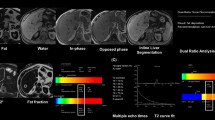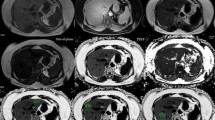Abstract
The purpose was to evaluate the ability of three magnetic resonance (MR) techniques to detect liver steatosis and to determine which noninvasive technique (MR, bioassays) or combination of techniques is optimal for the quantification of hepatic fat using histopathology as a reference. Twenty patients with histopathologically proven steatosis and 24 control subjects underwent single-voxel proton MR spectroscopy (MRS; 3 voxels), dual-echo in phase/out of phase MR imaging (DEI) and diffusion-weighted MR imaging (DWI) examinations of the liver. Blood or urine bioassays were also performed for steatosis patients. Both MRS and DEI data allowed to detect steatosis with a high sensitivity (0.95 for MRS; 1 for DEI) and specificity (1 for MRS; 0.875 for DEI) but not DWI. Strong correlations were found between fat fraction (FF) measured by MRS, DEI and histopathology segmentation as well as with low density lipoprotein (LDL) and cholesterol concentrations. A Bland-Altman analysis showed a good agreement between the FF measured by MRS and DEI. Partial correlation analyses failed to improve the correlation with segmentation FF when MRS or DEI data were combined with bioassay results. Therefore, FF from MRS or DEI appear to be the best parameters to both detect steatosis and accurately quantify fat liver noninvasively.





Similar content being viewed by others
References
Yan E, Durazo F, Tong M et al (2007) Nonalcoholic fatty liver disease: pathogenesis, identification, progression, and management. Nutr Rev 65:376–384
Yeh MM, Brunt EM (2007) Pathology of nonalcoholic fatty liver disease. Am J Clin Pathol 128:837–847
Schindhelm RK, Diamant M, Heine RJ (2007) Nonalcoholic fatty liver disease and cardiovascular disease risk. Curr Diab Rep 7:181–187
Farrell GC, Larter CZ (2006) Nonalcoholic fatty liver disease: from steatosis to cirrhosis. Hepatology 43:S99–S112
Angulo P (2002) Nonalcoholic fatty liver disease. N Engl J Med 346:1221–1231
Castera L, Negre I, Samii K et al (1999) Pain experienced during percutaneous liver biopsy. Hepatology 30:1529–1530
Joy D, Thava VR, Scott BB (2003) Diagnosis of fatty liver disease: is biopsy necessary? Eur J Gastroenterol Hepatol 15:539–543
Ratziu V, Charlotte F, Heurtier A et al (2005) Sampling variability of liver biopsy in nonalcoholic fatty liver disease. Gastroenterology 128:1898–1906
Vos MB, McClain CJ (2008) Nutrition and nonalcoholic fatty liver disease in children. Curr Gastroenterol Rep 10:308–315
Te Sligte K, Bourass I, Sels JP et al (2004) Non-alcoholic steatohepatitis: review of a growing medical problem. Eur J Intern Med 15:10–21
Canbakan B, Senturk H, Tahan V et al (2007) Clinical, biochemical and histological correlations in a group of non-drinker subjects with non-alcoholic fatty liver disease. Acta Gastroenterol Belg 70:277–284
Zafrani ES (2004) Non-alcoholic fatty liver disease: an emerging pathological spectrum. Virchows Arch 444:3–12
Charatcharoenwitthaya P, Lindor KD (2007) Role of radiologic modalities in the management of non-alcoholic steatohepatitis. Clin Liver Dis 11:37–54 viii
Szczepaniak LS, Nurenberg P, Leonard D et al (2005) Magnetic resonance spectroscopy to measure hepatic triglyceride content: prevalence of hepatic steatosis in the general population. Am J Physiol Endocrinol Metab 288:E462–E468
Hussain HK, Chenevert TL, Londy FJ et al (2005) Hepatic fat fraction: MR imaging for quantitative measurement and display—early experience. Radiology 237:1048–1055
Bydder M, Yokoo T, Hamilton G et al (2008) Relaxation effects in the quantification of fat using gradient echo imaging. Magn Reson Imaging 26:347–359
Thomsen C, Becker U, Winkler K et al (1994) Quantification of liver fat using magnetic resonance spectroscopy. Magn Reson Imaging 12:487–495
Nakae I, Mitsunami K, Omura T et al (2003) Proton magnetic resonance spectroscopy can detect creatine depletion associated with the progression of heart failure in cardiomyopathy. J Am Coll Cardiol 42:1587–1593
Longo R, Pollesello P, Ricci C et al (1995) Proton MR spectroscopy in quantitative in vivo determination of fat content in human liver steatosis. J Magn Reson Imaging 5:281–285
Kim H, Taksali SE, Dufour S et al (2008) Comparative MR study of hepatic fat quantification using single-voxel proton spectroscopy, two-point Dixon and three-point IDEAL. Magn Reson Med 59:521–527
Marsman H, Matsushita T, Dierkhising R et al (2004) Assessment of donor liver steatosis: pathologist or automated software? Hum Pathol 35:430–435
Promrat K, Lutchman G, Kleiner DE et al (2003) Pilot study of pioglitazone in nonalcoholic steatohepatitis. Gastroenterology 124:A-708
Perkins JD (2006) Saying “yes” to obese living liver donors: short-term intensive treatment for donors with hepatic steatosis in living-donor liver transplantation. Liver Transplant 12:1012–1013
Cotler SJ, Guzman G, Layden-Almer J et al (2007) Measurement of liver fat content using selective saturation at 3.0 T. J Magn Reson Imaging 25:743–748
Boulanger Y, Amara M, Lepanto L et al (2003) Diffusion-weighted MR imaging of the liver of hepatitis C patients. NMR Biomed 16:132–136
Irwan R, Edens MA, Sijens PE (2008) Assessment of the variations in fat content in normal liver using a fast MR imaging method in comparison with results obtained by spectroscopic imaging. Eur Radiol 18:806–813
Acknowledgements
The authors thank Dr. Marc Bilodeau and Mrs. Assia Belblidia for their help with the recruitment of patients and the radiology technologists for performing the MR experiments. The financial support from the Canadian Institutes of Health Research and from the Société Française de Radiologie (scholarship to G. d’A.) is gratefully acknowledged.
Author information
Authors and Affiliations
Corresponding author
Rights and permissions
About this article
Cite this article
d’Assignies, G., Ruel, M., Khiat, A. et al. Noninvasive quantitation of human liver steatosis using magnetic resonance and bioassay methods. Eur Radiol 19, 2033–2040 (2009). https://doi.org/10.1007/s00330-009-1351-4
Received:
Revised:
Accepted:
Published:
Issue Date:
DOI: https://doi.org/10.1007/s00330-009-1351-4




